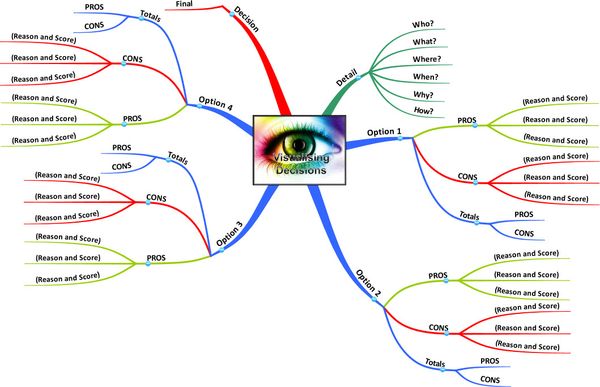Mind mapping tools have been around for many years. However, I'm starting to see a much wider adoption of mind mapping throughout my company and with the wider business audience.
Part 1 of this series, Using Mind Maps, examined mind mapping and why you might want to use its "radiant thinking" process. Here, in Part 2, we will look at some specific business uses for mind maps.
Below are four examples where mind mapping has proved useful to me recently.
Meeting Agendas: A mind map provides a great graphic overview of everything relating to the meeting, from attendee lists, meeting notes, web links, documents, to-do items, and parking lot issues.

Using the map during the meeting helps the team move above the details to keep the bigger picture in mind.
Employee Reviews: A mind map is helpful during the complete review life cycle.
- First, it's a great place to keep notes on how someone's doing and areas for improvement.
- Second, it's a great template to prompt the reviewer to look at the whole picture in a fair and balanced way.
- Third, the map is easy to share and revise.
In addition, while you may take the notes based on business categories like performance, potential, flexibility, and attitude - you might deliver the review based on a "Green", "Yellow", and "Red" metaphor that makes it easy for the employee to understand and act upon. Here is an example of that type of map.
Business Planning and Project Management: This was one of the first areas where mind maps proved useful. It's a great tool to see the forest and the trees.
Here is a simple decision-making template.
You will find that a mind map is a great tool to use interactively during meetings. It gives the team a common focus, yet allows the facilitator to adjust that focus efficiently and effectively.
In addition, Project View makes it easy to see the plan as a GANTT timeline or task table. This is a terrific added capability.
Communication and Presentation Tool: Mind maps allow great flexibility an structure during presentations. This facilitates a logical and organized presentation, as well as ad hoc interactive discussions.
More experienced mind mappers tend to use fewer words, opting to use images and the heuristic structure itself as a catalyst and reminder for deeper meaning.
An added bonus of using mind mapping software to present your ideas is that the map can be updated and re-ordered while you are using it. The map becomes the common-focus for an interactive discussion.
Cool special effects, like 3-D Views, turn your map into a 3 dimensional object, allowing you to glide around it from different angles, zoom in on different areas and transform presenting mind maps into a whole new experience. Here is an example.
Obviously, there are many other things you can do with mind maps.
Here is a link to Buzan's Gallery of Mind Maps and here is a link to BiggerPlate's Mind Map Gallery. In addition, here is a link to product tutorial videos.
The current generation of mind mapping tool is considerably more powerful, yet easier-to-use, than its predecessors. It's time to try it for yourself.




Sorry, but there’s no way one could bring one of these types of maps to the table at a Fortune 500. At best they look like my daughter’s 4th grade project. At worse….well, yeah. Great content and arguments for their usage, but there are far better examples to choose from.
Thanks for your comment.
I’ve been in plenty of meetings where people used mind maps, and he response has been overwhelmingly positive … especially when the map is used interactively.
I like using different colors to represent different things. However, it is easy to re-format with a much more “corporate” look. It is easy to comply if style dictates a more professional look.
This mind maps are really interesting. It is such a big help in planning businesses with your colleagues.